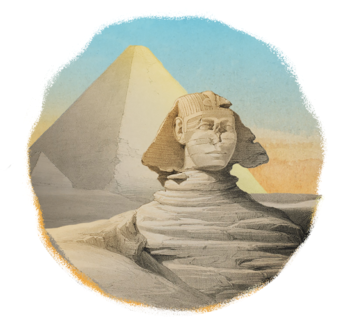
lesson 3 - Hatshepsut: The Forgotten Pharaoh
Hello! And welcome to week three of Puppet University. I’m your TA, writer and researcher Kari Koeppel. And I’m here to expand on The Professor’s lecture on competent ancient lady pharaoh, Hatshepsut.
But first, a note on last week’s Pompeii episode from one of your classmates.
In case you don’t remember, that bit of graffiti read, “Health to you, Victoria, and wherever you are may you sneeze sweetly.” Well, it turns out there might be something to what Catmanenergy says here, as the Latin word for clitoris, landica, may have fallen out of use and been replaced by nasum, or nose. Whoa. I’m not an expert in neither Classics nor Latin, so I can’t take this analysis much further than that: whoa.
Now, this week’s topic: Hatshepsut.
As the daughter of a pharaoh, Hatshepsut was trained from birth to rule as queen beside whichever brother would succeed the throne, as was custom. Although in previous eras Egyptian queens had very little power, during the New Kingdom period (in which Hatshepsut reigned) the queen became an essential part of her husband's regime. Having a queen was imperative: Pharaohs who tried to rule without one went against Maat, the divine order of the universe. Queens were given estates, which gave them a degree of financial independence.
Married at 12, Hatshepsut was likely only about 16 years old when her husband died. Since Hatshepsut didn’t have a son (she likely gave birth to one daughter), a boy born to a harem wife was chosen as his successor. The normal procedure was for the child’s mother to serve as regent, but since Thutmose II’s mother was low-born and lacked leadership training, that role fell to the highly qualified Hatshepsut. As Egpytologist Kara Cooney explains it: “The risk in a succession crisis of this kind was that a strong man — some kind of warlord with political and military backing — could take over, and the dynasty would switch to another family. But Hatshepsut was smart, skilled and strategic enough to support a baby and make sure that baby was educated and prepared to take the throne and continue the success of her dynasty.” Even though Hatshepsut herself was not supposed to rule, it was still her bloodline, and it was her familial duty to help the boy succeed.
A common misconception about Hatshepsut is that she was the first female pharaoh. She wasn’t, but only two, possibly three, other women had previously been pharaoh over the course of Egypt’s 3,000 years, all of whom — like Hatshepsut — only ruled when there was no suitable male successor. Each reigned for much briefer periods than Hatshepsut, who ruled for about 20 years.
As for Hatshepsut’s sterling reputation — to quote that mummified goose’s beautiful song, “Oh, just because she kept the peace she don’t deserve renown?” Like, carve that on my dang tombstone! Why are war and conquering prerequisites for glory? When a leader does their job right, everything should be smooth-sailing! For a pharaoh’s crowning achievement to be preventing war and other bad things from happening… that’s, like, unheard of in the ancient world. At one point in the episode, Ryann said Egypt seemed progressive — it wasn’t that the country was particularly progressive, but that it had the rare level-headed leader. Peace may not be flashy, but I’m sure Hatshepsut’s subjects appreciated it. And it was good for Egypt’s neighboring countries, too — instead of getting killed in battle or enslaved, they gained economic and cultural prosperity via trade with wealthy Egypt. We stan an efficient, caring leader who’s also a good neighbor!
Now, a few small questions that came up from the Ryan(n)s during class that I’d like to address:
Was there a pharaoh named Hotep? No, but it’s a common root word in pharah’s names, meaning peace. It probably sounds familiar because the mummy in The Mummy is named Imhotep. Also, apparently there's a Lego character named Hotep.
Was Nefertiti a pharaoh? Not exactly. She was queen to the pharaoh Akhenaten around 1370 BCE, though she may have pulled a Hatshepsut after her husband’s death and been co-regent to her husband’s son by another woman, Tutankhamun (you may have heard of him), though she never reigned as full pharaoh like Hatshepsut. Nefertiti was also mother to King Tut’s wife, aka his half-sister. A very gross custom!!
Did the ancient Egyptians bathe in milk and honey? People think this because Cleopatra, who lived about 1,400 years after Hatshepsut, reportedly bathed in sour donkey’s milk. Appetizing! But there’s no evidence that this would’ve been a custom for Hatshepsut. And apologies to the Beef Man, but I could find no evidence that J.Lo bathes in milk (Mariah Carey says she does, though).
Why is the location of the ancient land of Punt a mystery? This is a great article that explains all about it, but basically, no one ever wrote down explicit directions. We know it must’ve been near water, likely the Red Sea, because the ancient Egyptians took ships; but we also know that sometimes they took the land route. So they have a general area narrowed down, but nothing concrete.
And of course, there are some bigger picture questions that The Professor didn’t have time to get into. The Professor says it’s up to me, with my infinite wisdom and textual space, to address these controversial areas.
On the question of British imperial Egyptology: ooh baby, you gotta recognize by now that there are some problems here. First things first, you gotta know that Britain essentially ruled over Egypt from 1882-1922, and had lingeringcontrol well after that. This doesn’t really get taught in American schools! They’re just like, “oh yeah, Suez crisis, 1956, memorize it,” but give you little context for it. For decades before the crisis, the British were all up in Egypt (and every other country under British rule), diggin’ up antiquities and shipping them back to the British Museum. There’s an inherent conflict here: what right did the British have to these items? It’s the problem of imperialism. Almost everything in Western museums from ancient times, if not on loan from its country of origin, was acquired by dubious means. That being said, were the British archeologists and Egyptologists particularly problematic themselves? Was Howard Carter specifically a problematic dude? No. But was he a part of a problematic system? 100%, for sure. Like I said, it’s a whole ~thing~.
Now, on the issue of Hatshepsut being depicted as a man in later artworks: it’s complicated. Was she trans? Was she queer? We can’t be sure for a number of reasons, mainly that the ancient Egyptians did not have the same ideas and language regarding gender and sexuality that we have today, and because any information that might’ve helped us better understand those nuances have been lost to time. Of course, it’s worth noting that most people who’ve studied this have been straight cisgender men. That means there’s been a limited viewpoint and perspective directed at this question, and because of that, undoubtedly, there are ideas and theories that have been under-researched and under-explored. Historically, there is a bias in academia leaning towards the straight, white, cisgender, male, Christian point of view. There are those who argue: Since we’ll never know for certain, why rule out the possibility that Hatshepsut was queer? And I think that’s a fair point!
Phew! Thanks for sticking with me through all that. I have absolutely no power to do this, but I say you all get a history point for making it this far.



